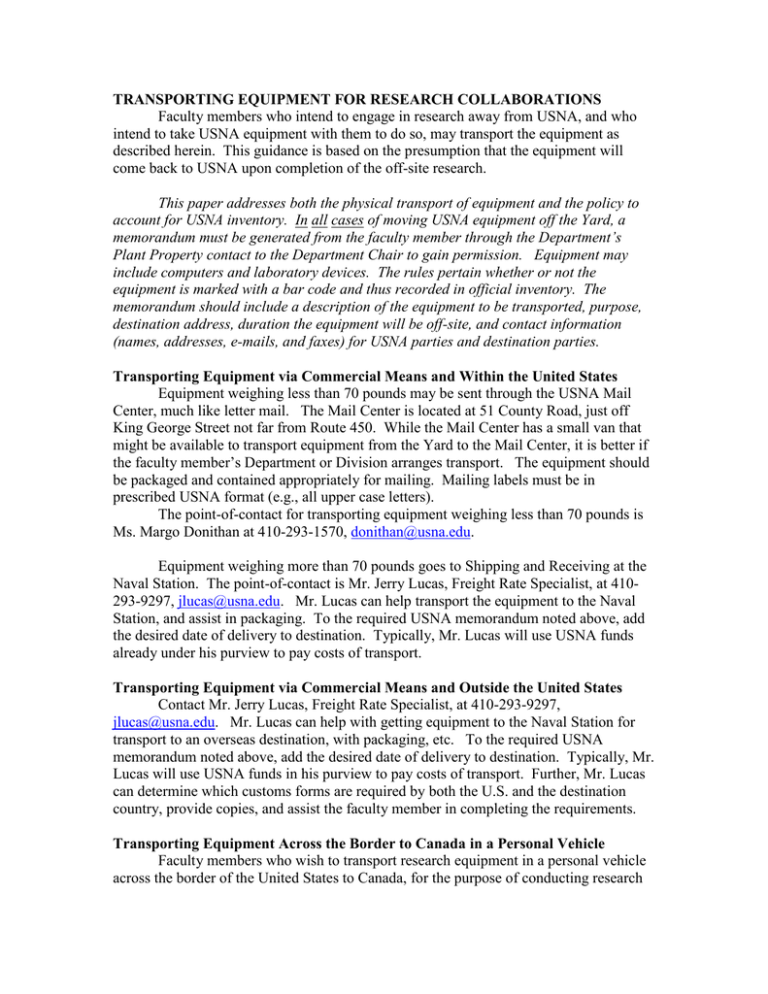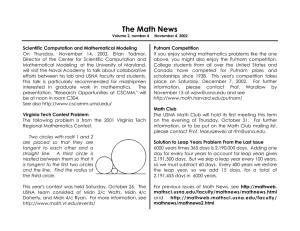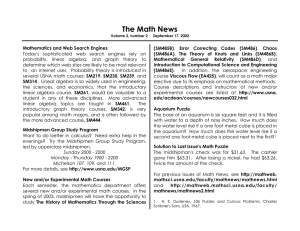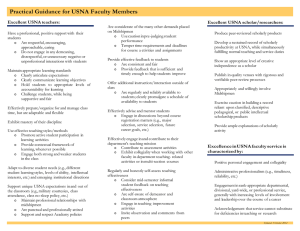TRANSPORTING EQUIPMENT FOR RESEARCH COLLABORATIONS
advertisement

TRANSPORTING EQUIPMENT FOR RESEARCH COLLABORATIONS Faculty members who intend to engage in research away from USNA, and who intend to take USNA equipment with them to do so, may transport the equipment as described herein. This guidance is based on the presumption that the equipment will come back to USNA upon completion of the off-site research. This paper addresses both the physical transport of equipment and the policy to account for USNA inventory. In all cases of moving USNA equipment off the Yard, a memorandum must be generated from the faculty member through the Department’s Plant Property contact to the Department Chair to gain permission. Equipment may include computers and laboratory devices. The rules pertain whether or not the equipment is marked with a bar code and thus recorded in official inventory. The memorandum should include a description of the equipment to be transported, purpose, destination address, duration the equipment will be off-site, and contact information (names, addresses, e-mails, and faxes) for USNA parties and destination parties. Transporting Equipment via Commercial Means and Within the United States Equipment weighing less than 70 pounds may be sent through the USNA Mail Center, much like letter mail. The Mail Center is located at 51 County Road, just off King George Street not far from Route 450. While the Mail Center has a small van that might be available to transport equipment from the Yard to the Mail Center, it is better if the faculty member’s Department or Division arranges transport. The equipment should be packaged and contained appropriately for mailing. Mailing labels must be in prescribed USNA format (e.g., all upper case letters). The point-of-contact for transporting equipment weighing less than 70 pounds is Ms. Margo Donithan at 410-293-1570, donithan@usna.edu. Equipment weighing more than 70 pounds goes to Shipping and Receiving at the Naval Station. The point-of-contact is Mr. Jerry Lucas, Freight Rate Specialist, at 410293-9297, jlucas@usna.edu. Mr. Lucas can help transport the equipment to the Naval Station, and assist in packaging. To the required USNA memorandum noted above, add the desired date of delivery to destination. Typically, Mr. Lucas will use USNA funds already under his purview to pay costs of transport. Transporting Equipment via Commercial Means and Outside the United States Contact Mr. Jerry Lucas, Freight Rate Specialist, at 410-293-9297, jlucas@usna.edu. Mr. Lucas can help with getting equipment to the Naval Station for transport to an overseas destination, with packaging, etc. To the required USNA memorandum noted above, add the desired date of delivery to destination. Typically, Mr. Lucas will use USNA funds in his purview to pay costs of transport. Further, Mr. Lucas can determine which customs forms are required by both the U.S. and the destination country, provide copies, and assist the faculty member in completing the requirements. Transporting Equipment Across the Border to Canada in a Personal Vehicle Faculty members who wish to transport research equipment in a personal vehicle across the border of the United States to Canada, for the purpose of conducting research and with the intent of returning to the United States with the equipment, must meet customs requirements for both countries. For United States Customs: registration Complete form CBP-4455 (Certificate of Registration). This form is used typically by businesses transporting equipment of high value and/or on a large scale. Form CBP-4457 (Certification of Registration for Personal Effects Taken Abroad) has also been accepted, although typically this form is used by tourists carrying smaller, personal, and lesser-value items like cameras or computers. Take the form and equipment to the Customs and Border Patrol Office at Baltimore-Washington International (BWI) airport to register the equipment prior to travel. No appointment is necessary. The address is Cargo Drive, Building F, Suite 1200 (off of Aviation Blvd at BWI). A customs officer will inspect equipment, verify serial numbers, and stamp paperwork. Allow one hour plus travel time for the registration and inspection process. Questions about U.S. customs may be directed to the Duty Office of Customs and Border Protection at BWI airport at 410-865-2100, ext. 100, from 0600-2200. border crossing At the border to exit the United States, just drive across. If you are selected for inspection before exiting, produce the signed and stamped paperwork. For Canadian Customs: registration Ahead of time, complete form E29B available from http://www.cbsa-asfc.gc.ca. border crossing Upon entering Canada, show the U.S. and Canadian paperwork at passport control. You will have to go to a separate Canada Border Services Agency (CBSA) area for processing. Typically, the CBSA will collect a deposit on the equipment. The collection of the deposit is based on the presumption that the equipment is intended for sale; the CBSA is thus collecting tariff. Depending on the climate at the time of transit, it is possible that presentation of official passport and travel orders, along with other evidence of the government business, will prompt the CBSA to forego collecting tariff. In any case, the deposit will be returned when it becomes apparent, upon exiting Canada, that you did not sell the equipment in Canada. Contact the CBSA at 204-983-3500 or 506-636-5064 to estimate tariff ahead of time. Entry to Canada and processing through the CBSA takes 15-30 minutes. Upon leaving Canada, stop at the CBSA office to show the signed and stamped forms. If you fail to stop, the CBSA will track you down to collect tariff on the equipment on the presumption that you did not “re-export” the equipment. Also, if you fail to stop and had paid a deposit upon earlier entry, you may lose the deposit.


